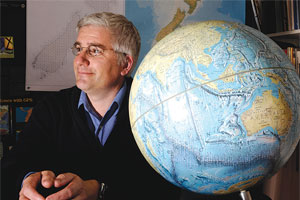Paleontology flourishes in ‘Chicago-zoic’ era
By Steve Koppesskoppes@uchicago.edu
News Office
 Photo by Dan Dry Michael Foote |
|
To a casual reader, only three of the 35 co-authors of a landmark paper on paleobiology that appeared in the July 4 issue of the journal Science held any connection to the University of Chicago. But dig deeper, and a different story emerges.
“This paper has Chicago written all over it,” said Michael Foote (Ph.D.,’89), Professor in Geophysical Sciences and the College. Joining Foote as co-authors of the article were Andrew Krug and Adam Tomasovych, both postdoctoral scientists in Geophysical Sciences. But another nine of their co-authors earned their Ph.D.s at Chicago, and a 10th formerly worked at the University as a postdoctoral scientist.
And that’s merely the top layer of Chicago’s influence on this paper, which “represents an extraordinary transformation of our understanding of the diversity of marine invertebrate life, at least over the last 530 million years,” said David Rowley, Professor in Geophysical Sciences and the College.
As readers probe deeper into the text and its bibliography, they see key references from two more Chicago paleontologists: the late Jack Sepkoski, Professor in Geophysical Sciences, and David Raup, the Sewell Avery Distinguished Service Professor Emeritus in Geophysical Sciences and the College.
“The quest to understand the history of biodiversity has long underlain research at the leading edge of paleobiology,” Foote said. “Jack Sepkoski was undoubtedly the leader in these efforts, and his work has been a touchstone for all subsequent research.”
This research includes attempting to document the basic pattern of change through the history of life on Earth. Potentially working to distort this pattern are an incomplete geologic record and its biased sampling.
For example, the amount of exposed sedimentary rock varies as a function of age, without a systematic trend. With greater exposure of sedimentary rocks, there is likely to be a correlation between the amount these beds have been studied and the number of fossil varieties described from them. Without a good understanding of these effects, “the concern is that one is simply sampling the rock record, not diversity of life through time,” Rowley said.
And Raup coined the term “Pull of the Recent” to describe a sampling bias that works against extinct species. It stems from the practice of extending the ranges of living organisms beyond their actual fossil occurrences to the present day. Paleontologists would potentially see a lesser increase in diversity if they only used fossil data to document the history of life, Foote said.
Nevertheless, Sepkoski, Raup and two colleagues published a 1981 paper in Nature suggesting that global diversity truly has increased over the last few hundred million years. Yet lingering doubts fueled additional research.
In the early 1990s, Arnold Miller (Ph.D.,’86), professor of geology at the University of Cincinnati, realized that then-existing data compilations limited the questions they could address. These compilations recorded only the first and last appearance of an organism in the fossil record.
In order to study the pronounced diversification of marine life during the Ordovician Period (505 to 438 million years ago), he began to compile more extensive data from the primary paleontological literature. Miller collected a large sample of all known occurrences in the fossil record, including first and last appearance, geographic locality and depositional environment.
The compilation showed that the amount of data varied at intervals within the Ordovician. How, then, would the history of marine diversity appear if he adjusted for this variation by taking the same amount of data from each time interval?
Miller published his results, with Foote as co-author, in Paleobiology in 1996. The raw data had suggested a steady increase in diversity throughout much of the Ordovician. But after Miller and Foote had standardized the data, it appeared that diversity had reached a plateau by the middle Ordovician.
“Now it seemed that marine life had radiated much more rapidly than was previously thought,” Foote said.
Miller’s compilation in 1998 inspired two other Chicago alumni to launch a more ambitious project. The alumni were John Alroy (Ph.D.,’94), now a research associate at the National Center for Ecological Analysis and Synthesis, and Charles Marshall (Ph.D.,’90), now a professor of biology and geology at Harvard University.
The project, called the Paleobiology Database, became an international effort to electronically archive data that covers the last 570 million years of life on Earth. Alroy, Marshall and 23 co-authors, including Foote, drew upon their new database in 2001 to standardize the sampling for 300 million years of that history.
Sepkoski’s earlier work had helped convince many paleobiologists that diversity had continued to grow relatively unfettered since the Paleozoic Era, which ended 250 million years ago. But some of Alroy and Marshall’s preliminary findings, published in 2001, challenged that interpretation.
In recent years, the team has continued to enhance the Paleobiology Database in order to address its possible shortcomings. Their latest paper in Science still suggests that, after standardizing the sampling, the net diversification of marine life has remained relatively limited since the middle Paleozoic.
The paper also shows surprisingly rapid diversity increases following the mass extinctions that occurred 250 million and 65 million years ago. “The marine biota has a stronger capacity to recover from such major events than would have been thought,” Foote said.
Such statistical assessments of the fossil record have long been a hallmark of paleobiology research at the University. Now Chicago alumni who adhere to similar principles are running programs of their own, said David Jablonski, the William Kenan Jr. Professor in Geophysical Sciences and the College.
“‘The Chicago School,’ as we were called in The New York Times, continues to fuel this quantitative approach to paleobiology that has become increasingly influential,” he said.
![[Chronicle]](/images/sidebar_header_oct06.gif)